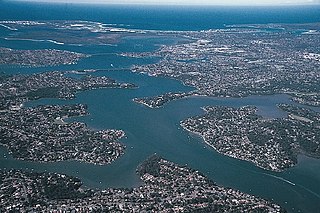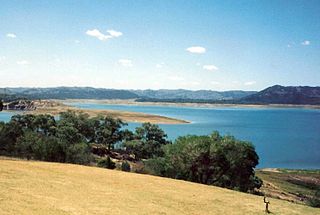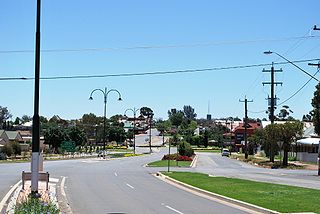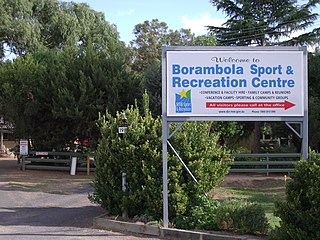
The Georges River, formerly known as Tucoerah River, is an intermediate tide dominated drowned valley estuary, located to the south and west of Sydney, New South Wales, Australia.

Harden-Murrumburrah is a township and community in the Hilltops Region and is located in the South West Slopes of New South Wales in Australia and is adjacent to both the Canberra region of the Australian Capital Territory and the Riverina Region in the southwest area of NSW. The town is a twin town between Harden and Murrumburrah.

Wellington is a town in inland New South Wales, Australia, located at the junction of the Macquarie and Bell Rivers. It is within the local government area of Dubbo Regional Council. The town is 362 kilometres (225 mi) from Sydney on the Great Western Highway and Mitchell Highway.

Lake Burrendong is a man-made reservoir created by Burrendong Dam. It impounds waters on the Macquarie and Cudgegong rivers, near Wellington, in the central west region of New South Wales, Australia.

The Hawkesbury River, is a semi–mature tide dominated drowned valley estuary located to the west and north of Sydney, New South Wales, Australia. The Hawkesbury River and its associated main tributary, the Nepean River, virtually encircle the metropolitan region of Sydney.

Windsor is a historic town north-west of Sydney, New South Wales, Australia. It is in the Hawkesbury local government area, in the region of Greater Western Sydney. The town sits on the Hawkesbury River, enveloped by farmland and Australian bush. Many of the oldest surviving European buildings in Australia are located at Windsor. It is 46 kilometres (29 mi) north-west of metropolitan Sydney, on the fringes of urban sprawl.

Keepit Dam is a major gated mass concrete gravity dam with an earth fill abutment and a central gated concrete overflow crest and six radial gate spillways across the Namoi River upstream of its junction with the Peel River in the North West Slopes region of New South Wales, Australia. The dam's purpose includes flood mitigation, hydro-power, irrigation, water supply and conservation. The impounded reservoir is called Lake Keepit.

Hornsby Shire is a local government area situated on the Upper North Shore and Northern Suburbs of Sydney, as well as parts of the Hills District, in the state of New South Wales, Australia. The Shire stretches from the M2 Hills Motorway in the south to the Hawkesbury River town of Wisemans Ferry, some 53 kilometres (33 mi) to the north, making it the largest local government council in the Greater Sydney Metropolitan region in terms of total area. As of the 2016 census the Shire had an estimated population of 142,667.

The Milsons Point railway station is a heritage-listed railway station located on the North Shore line, serving the Sydney suburb of Milsons Point in New South Wales, Australia. It is served by Sydney Trains T1 North Shore line services. The station is located above ground, accessible via an aqueduct, in Milsons Point, in the North Sydney Council local government area of New South Wales, Australia. It was designed and built by the Sydney Harbour Bridge Branch of the NSW Department of Public Works. The property is owned by RailCorp, an agency of the Government of New South Wales. It was added to the New South Wales State Heritage Register on 2 April 1999.

The Waverton railway station is a heritage-listed railway station located on the North Shore line, serving the Sydney suburb of Waverton in New South Wales, Australia. It is served by Sydney Trains T1 North Shore line services. The station is located on Bay Road, Waverton, in the North Sydney Council local government area of New South Wales, Australia. It was designed and built by New South Wales Department of Railways. It is also known as Waverton Railway Station group. The property is owned by RailCorp, an agency of the Government of New South Wales. The station was added to the New South Wales State Heritage Register on 2 April 1999.

Milson Island is located in New South Wales, Australia. It was first settled over 100 years ago and has been used as a bacteriological station, quarantine station, a hospital to treat soldiers from WWI with venereal disease, mental hospital, a rehab for alcoholics, a women's jail, and now a sports and recreation centre.

Jindabyne is a town in south-east New South Wales, Australia that overlooks Lake Jindabyne near the Snowy Mountains, in Snowy Monaro Regional Council. It is a popular holiday destination year round, especially in winter. This is due to its proximity to major ski resort developments within the Kosciuszko National Park, including Thredbo, Perisher and Charlotte Pass.

Coolamon is a town in the Riverina region of south-west New South Wales, Australia. Coolamon is 40 kilometres (25 mi) north-west of Wagga Wagga and 506 kilometres (314 mi) south-west of Sydney via the Hume and Sturt Highways. The town is situated on the railway line between Junee and Narrandera. Coolamon had a population of 2,199 at the 2016 census and is 290 metres (950 ft) above sea level. It is the administrative and service centre for the local government area which bears its name—Coolamon Shire.
Little Wobby is a suburb of the Central Coast region of New South Wales, Australia, located on the north bank of the Hawkesbury River. It is part of the Central Coast Council local government area.
Patonga is a suburb of the Central Coast region of New South Wales, Australia, located on the north bank of the Hawkesbury River, southwest of Woy Woy. It is part of the Central Coast Council local government area.
The State Parks of New South Wales are eighteen protected areas in New South Wales, Australia reserved for camping, water sports and recreational uses. State Parks are maintained by the New South Wales Department of Lands and managed by community trust boards.

Borambola is a rural community in the central east part of the Riverina. It is situated on the Sturt Highway about 16 kilometres east of Alfredtown and 30 kilometres east of Wagga Wagga. At the 2006 census, Borambola had a population of 129 people.
Myuna Bay is a suburb of the City of Lake Macquarie in New South Wales, Australia, and is located west of Lake Macquarie near Wangi Wangi.

Arts NSW (ANSW) is an agency of the Government of New South Wales responsible for administering the government's policies that support the arts, artists and the various cultural bodies within the state of New South Wales in Australia. Arts NSW is led by its Executive Director, Mary Darwell, who reports to the Secretary of the Department of Justice, Andrew Cappie-Wood. The agency advises the Minister for the Arts, presently the Hon. Don Harwin MLC, who is ultimately responsible to the Parliament of New South Wales.
Lake Macquarie State Conservation Area is a 761-hectare (1,880-acre) conservation area in New South Wales Australia, approximately 20 kilometres (12 mi) from Newcastle. It is made up of six separate land sections around the coastal saltwater Lake Macquarie, covering 16 kilometres (10 mi) of the lake's foreshore. Though most of the area was declared in 1996 one section, the Morisset area, was added in January 1999.

















